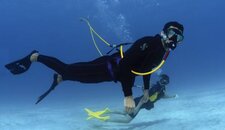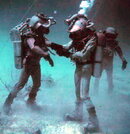ams511
Contributor
Tobin, already answered your question so I will try to keep it brief. If the diver takes time to descend to 130 ft (and uses air) he will just be less negative and need to inflate the wing less. I was trying to keep the math simple. As Tobin already mentioned at 15 ft a + 25 lb wet suit is around + 17 (25/1.5=16.67). So it already lost 8 lbs. (25 - 17 = 8) of buoyancy. This 8 lbs should cover the weight of air in most tanks. In fact the diver may need to inflate the BC a bit.I think where you are getting confused is the difference between warm water and cold water diving. If you are diving with a skin in warm water, there is no compression in the skin so the only thing you need to worry about is if the wing floats your rig. However when doing the weighting the diver should be able to hold a stop at 15 ft with 500 PSI in his tank. This would translate to being roughly maybe 5 lbs heavy during the start of the dive. As the air gets used up the diver becomes more neutral and needs to vent. Remember the weighting is done first and then the wing size is determined.We are not talking about weighting for the dive, but rather the lift needed. In order to be neutral with an empty tank at the end of the dive, at a depth of 1 foot, the diver will need to carry extra ballast to offset the weight of the air used. If he does not, then he will float up. Proper (or minimum) weighting will make him neutral with an MT BC, and an MT tank at the surface. So, this means that when he starts his dive, with a full tank and at a depth of zero he MUST be over-weighted by an amount exacty equal to the weight of the air in the tank. So when he descends to 130 ft, (in zero seconds, without using any air ),, what will be his buoyancy situation? The answer is ... he will be negative by an amount exactly equal to the suit compression AND the weight of air in his tank(s). So in order to establish neutral condition - the wing MUST have the capacity to offset the negative force generated by suit compression AND the weight of the gas in the tank(s).






